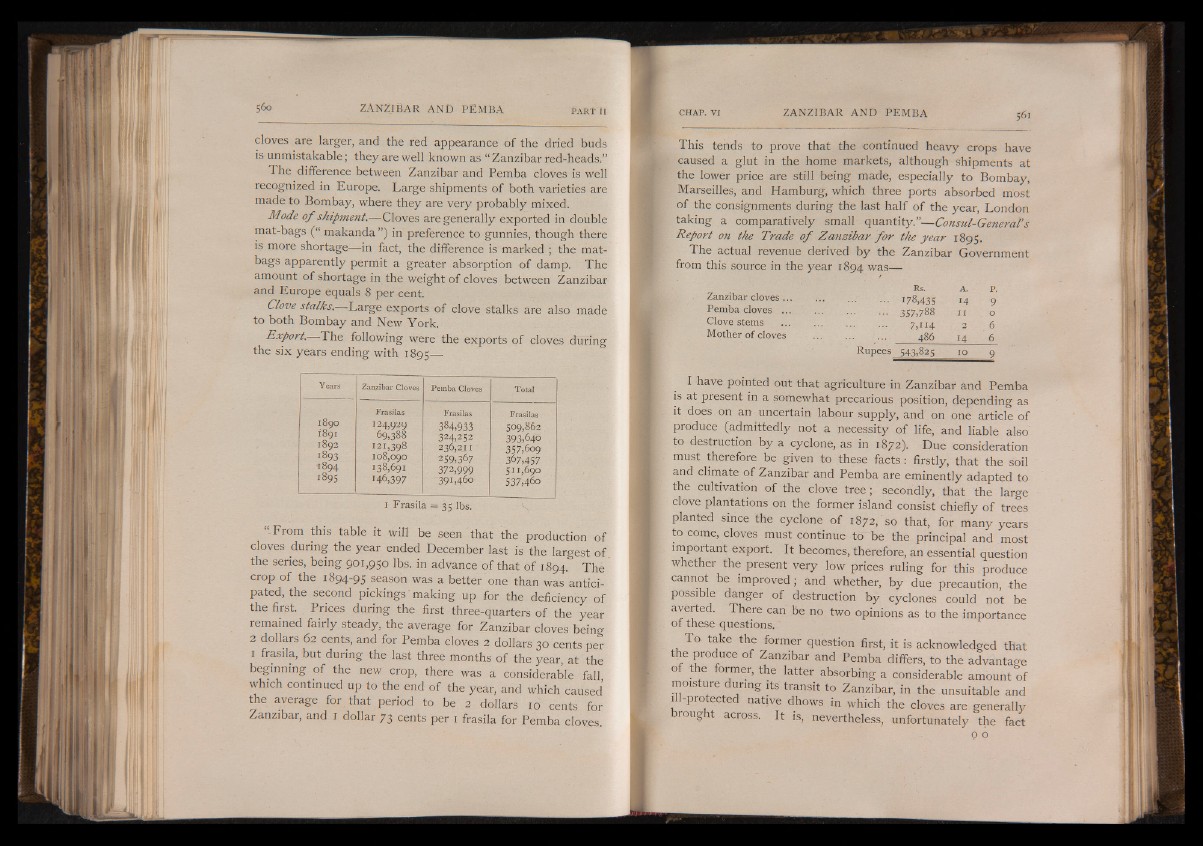
cloves are larger, and the red appearance of the dried buds
is unmistakable; they are well known as “ Zanzibar red-heads.”
The difference between Zanzibar and Pemba cloves is well
recognized in Europe. Large shipments of both varieties are
made to Bombay, where they are very probably mixed.
Mode o f shipment.— Cloves are generally exported in double
mat-bags (“ makanda ”) in preference to gunnies, though there
is more shortage— in fact, the difference is marked ; the mat-
bags apparently permit a greater absorption of damp. The
amount of shortage in the weight of cloves between Zanzibar
and Europe equals 8 per cent.
Clove stalks.— Large exports of clove stalks are also made
to both Bombay and New York.
Export. The following were the exports of cloves during
the six years ending with 1895—
Years Zanzibar Cloves Pemba Cloves Total
1890
Frasilas Frasilas Frasilas
12 4 ,9 2 9 38 4 ,9 33 509 ,8 6 2
18 9 1 69 ,38 8 3 2 4 ,2 5 2 39 3 ,6 40
18 9 2 1 2 1 ,3 9 8 2 3 6 ,2 3 1 3 5 7 ,6 0 9
1893 108,090 2 5 9 ,3 6 7 3 6 7 ,4 5 7
1 8 9 4 13 8 ,6 9 1 3 7 2 ,9 9 9 5 1 1 ,6 9 0
18 9 5 1 4 6 ,3 9 7 3 9 1 ,4 6 0 5 3 7 ,4 6 0
1 Frasila = 35 lbs.
“ From this table it will be seen that the production of
cloves during the year ended December last is the largest of
the series, being 901,950 lbs. in advance of that of 1894. The
crop of the 1894-95 season was a better one than was anticipated,
the second pickings' making up for the deficiency of
the first. Prices during the first three-quarters of the year
remained fairly steady, the average for Zanzibar cloves being
2 dollars 62 cents, and for Pemba cloves 2 dollars 30 cents per
1 frasila, but during the last three months of the year, at the
beginning of the new crop, there was a considerable fall
which continued up to the end of the year, and which caused
the average for that period to be 2 dollars 10 cents for
Zanzibar, and 1 dollar 73 cents per 1 frasila for Pemba cloves.
This tends to prove that the continued heavy crops have
caused a glut in the home markets, although shipments at
the lower price are still being made, especially to Bombay,
Marseilles, and Hamburg, which three ports absorbed most
of the consignments during the last half of the year, London
taking a comparatively small quantity.”— Consul-General's
Report on the Trade o f Zanzibar fo r the year 1895.
The actual revenue derived by the Zanzibar Government
from this source in the year 1894 was—
Rs. a . p.
Zarmbar cloves... ... 178,435 14 9
Pemba cloves ... ... ............... 357,788 u 0
Clove stems ... 7jII4 2 6
Mother of cloves .......................... 486 14 6
Rupees 543,825 10 9
I have pointed out that agriculture in Zanzibar and Pemba
is at present in a somewhat precarious position, depending as
it does on an uncertain labour supply, and on one article of
produce (admittedly not a necessity of life, and liable also
to destruction by a cyclone, as in 1872). Due consideration
must therefore be given to these facts: firstly, that the soil
and climate of Zanzibar and Pemba are eminently adapted to
the cultivation of the clove tree; secondly, that the large
clove plantations on the former island consist chiefly of trees
planted since the cyclone of 1872, so that, for many years
to come, cloves must continue to be the principal and most
important export. It becomes, therefore, an essential question
whether the present very low prices ruling for this produce
cannot be improved ; and whether, by due precaution, the
possible danger of destruction by cyclones could not be
averted. There can be no two opinions as to the importance
of these questions.~
To take the former question first, it is acknowledged that
the produce of Zanzibar and Pemba differs, to the advantage
of the former, the latter absorbing a considerable amount of
moisture dunng its transit to Zanzibar, in the unsuitable and
H proiec e native dhows in which the cloves are generally
brought across. It is, nevertheless, unfortunately the fact
00